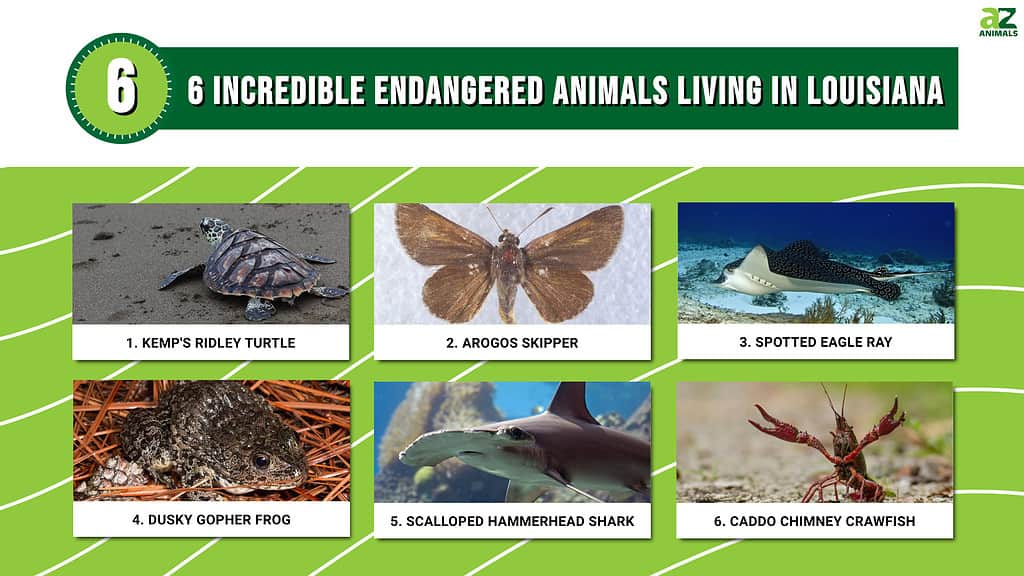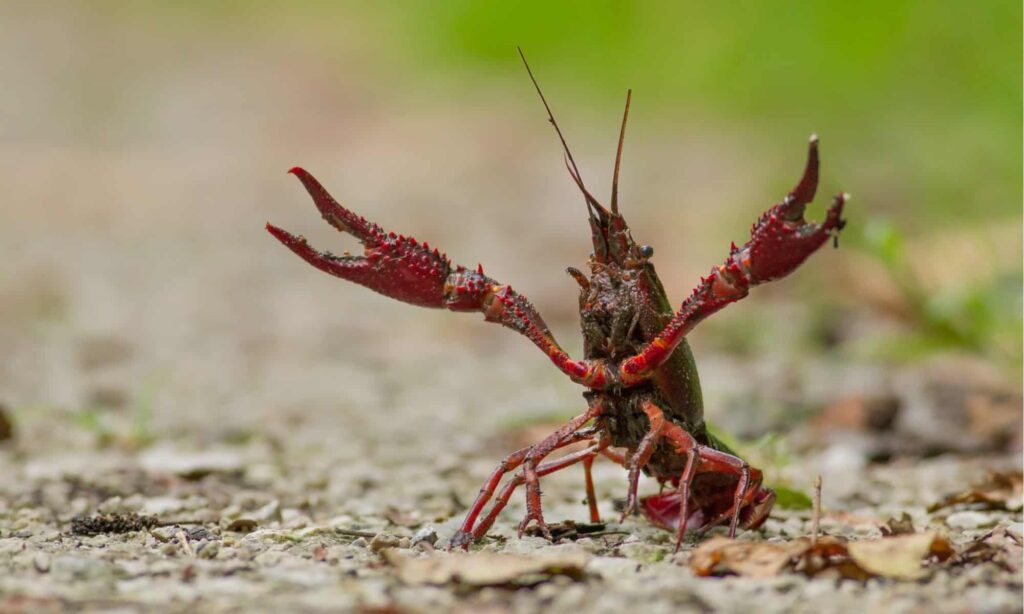
Also known as the Bayou State, it’s no wonder that Louisiana has a number of incredible endangered animals. From the silty shores of the Mississippi River to the thriving coniferous forests, this state has plenty to offer, both to humans and animals. There are a number of endangered animals in Louisiana, but what makes them special, and just how rare are they?
In this article, we will discuss 6 of the rarest and most threatened animals found in the state of Louisiana, including some creatures that are endemic to this particular state. We’ll talk about why these animals might be endangered in the first place, the ecosystems they live in, and why they’re important. From marshes to marinas, here are 6 incredible and endangered animals found in Louisiana!
1. Kemp’s Ridley Turtle

Capable of reaching up to 100 pounds and 2 feet long, the Kemp’s ridley
sea turtle
is the smallest sea turtle in the world.
©Mahmud Hidayat/Shutterstock.com
While most Kemp’s ridley turtles can be found nesting along warm and sunny beaches in Mexico, this rare and small sea turtle once thrived in Louisiana. However, this turtle is now classified as endangered, if not critically. While this is likely due to habitat loss, many studies suggest that bycatch is the biggest threat facing these rare sea turtles. A lack of females within the species may also be a cause for concern.
Capable of reaching up to 100 pounds and 2 feet long, the Kemp’s ridley sea turtle is the smallest sea turtle in the world. These turtles are unique in that all females nest along the same shoreline at the same time. They also nest during the day, likely to help promote the survival of their young. Known as arribada nesting, Kemp’s ridley turtles are one of only two turtle species that lay their eggs in this manner. It’s a method that scientists still can’t quite explain!
2. Arogos Skipper

Orange-brown in color and relatively small, the Argos skipper has a wingspan of fewer than 2 inches.
©Charles T. and John R. Bryson, , Bugwood.org / CC BY 3.0 US – License
Classified as Atrytone arogos, the Argos skipper is endangered and extremely limited to its environments within the United States. Orange-brown in color and relatively small, the Argos skipper has a wingspan of fewer than 2 inches. The primary reason why this particular butterfly is so rare is that it thrives in prairies and undisturbed regions of the United States, particularly grassland areas often destroyed by wildfires.
3. Spotted Eagle Ray

Often seen jumping into the air from the depths of the sea, spotted eagle rays have lept onto boats.
©iStock.com/eaglerayjoel
Found globally in tropical waters, the spotted eagle ray can be found along the Louisiana coastline. However, it is considered endangered and only frequently sighted in locations closer to Florida. Often seen jumping into the air from the depths of the sea, spotted eagle rays have lept onto boats. In fact, a woman in the Florida Keys tragically lost her life to a spotted eagle ray when it crashed into her.
For the most part, spotted eagle rays are considered endangered due to commercial fishing as well as commercial catching for aquariums. Given that these beautiful rays reach impressive sizes (including ten-foot-long wingspans!), they are popular in public displays and aquariums. However, they are often bred unsuccessfully and captured unethically.
4. Dusky Gopher Frog

The Endangered Gopher Frog, Rana capito
©Nathan A Shepard/Shutterstock.com
When it comes to endangered animals in Louisiana, the dusky gopher frog is one of the rarest. Endemic to southern states, the dusky gopher frog is only found in the state of Mississippi currently. That’s why it’s also called the Mississippi gopher frog! It once had a population in Louisiana, but that population has declined greatly in recent years due to habitat loss, primarily of long-leaf forested regions that they call home.
Fortunately, the US Forest Service as well as many zoos in the United States, including the New Orleans Zoo, have begun conservation efforts to restore the dusky gopher frog population. While their status in the wild is nearly extinct, many breeding programs and partnerships hope to restore this frog and strengthen its population as a whole!
5. Scalloped Hammerhead Shark

Unfortunately, the scalloped hammerhead (alongside smooth hammerheads) is frequently caught in commercial fishing catches.
©Ian Scott/Shutterstock.com
Classified as Sphyrna lewini, the scalloped hammerhead shark is a species of hammerhead. It’s found in warm coastal waters and occasionally deeper seas around the world. Unfortunately, the scalloped hammerhead (alongside smooth hammerheads) is frequently caught in commercial fishing catches. Shark fins are highly prized for culinary purposes and are considered a delicacy around the world.
The average scalloped hammerhead can reach anywhere from 6-10 feet long, depending on gender. The large sizes of these sharks make them ideal targets for the shark fin industry. Their harvest is exacerbated by the fact that they often gather and give live birth in the same locations. They also give birth in larger groups, making them easier to find and catch. Some regulations have been put into place to protect the scalloped hammerhead, but they are still considered critically endangered.
6. Caddo Chimney Crawfish

A male uses their claws by pinching or jabbing their rival.
©rugco/Shutterstock.com
Technically only found in the Walter B. Jacobs Memorial Nature Park in Louisiana, the Caddo chimney crawfish is classified as Procambarus machardyi. Given its limited habitat occupation and its recent discovery in 2006, this particular crawfish is extremely endangered. To protect themselves from predators, most crawfish create burrows or stacks of dirt known as chimneys, and the Caddo chimney crawfish is no exception!
The photo featured at the top of this post is © lavizzara/Shutterstock.com
Thank you for reading! Have some feedback for us? Contact the AZ Animals editorial team.






